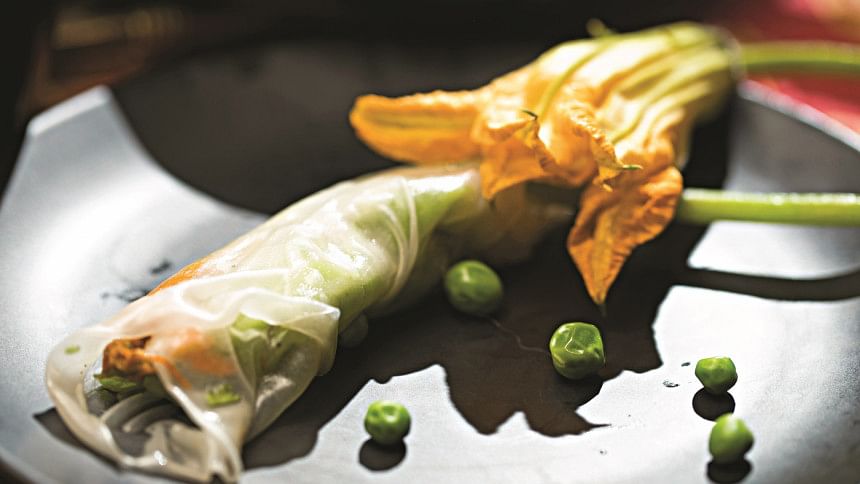Floral delicacies

Flowers are a joyous thing to look at, beautiful as decorations, appreciated in the home, and loved as gifts. Another thing we often overlook about this beautiful creation is that they are edible. But it is also important to note that not all flowers are edible, and that there are restrictions to them.
Edible flowers should be grown organically and without any pesticides, which is why growing your own is a great idea, as you get to monitor what you are consuming if you cannot source them properly. Every flower has a distinct scent, taste, and texture to it. This is why we can enjoy them in lot of different foods.
CITRUSY APPLE BLOSSOM
Apple blossom has a citrusy and sour flavour that goes well with crunchy and juicy salads. They can also be used as garnishes when candied with sugar to be put on desserts. However, it is important to source it properly from stores, since wild ones can be poisonous.
MULTI-FLAVOURED ROSE
Roses have a very soft flavour that can have numerous undertones, sometimes fruity, sweet, or even sour, depending on the colour of the flower. The stronger the colour, the stronger the flavours. Great with drinks, salads or with a little effort, it can even make rose petal jam.
TEXTURED TULIPS
Tulips have a very crisp texture which resembles the lettuce and has a flavour similar to the pea. Tulip petals are usually added as strips to sandwiches, or to salads to add in some fun colours. The flowers however can cause allergies to surface in people who are sensitive, so removing all the pollen and stigmas are crucial before adding them to food.
FRUITY HIBISCUS
Hibiscus petals have a fruity taste to them, somewhat citrusy and berry like. This makes them great to make tea with, and are also added to food like salads to add pops of colour.
SOOTHING LAVENDER
A sweet and citrus flavour, with hints of rosemary and mint scents are what describes the lavender. Used in a wide array of culinary items, lavender can be used to make lavender sugar for jams and sorbets, or used as a medium for meat sauces. Lavender oil however should not be used as it can be poisonous and is not used for consumption.
BEAUTIFUL MARIGOLD
Marigold is often considered to be an alternative to saffron, which is on the more expensive side. It has a pleasant citrusy and bitter taste to it, and is more available than saffron. It is normally added to food where you would want a little zest, like warm desserts.
Only the petals of the flower can be eaten and should be done moderately, as consuming large portions can be harmful.
At one time, flowers used to be a garnish we would throw away, but with the discovery of their food values over time, we are thankful that we get to not only visually enjoy them, but can consume these flowers as a delicacy as well.
ROSES
Roses have been a major part of Mediterranean dishes for the longest time. And recently, the entire world seems to have taken a keen interest towards this majestic pick because it can be used as garnish to grand Mughal cuisines to being used as a major sleep enhancer when immersed in tea.
Deshi treats

PUMPKIN FLOWERS
Pumpkin Flowers make the most delicious fritters ever imagined. With an abundance of B vitamins, iron, calcium and folate, this delicious blossom seems to be the choicest of nutrition to be enjoyed during pregnancy.
LOTUS STEMS
This delicious addition is a common vegetable in Indian and Bengali cuisine. By bringing it into your kitchen, you are also bringing in a rich source of calcium, iron and fibre. Lotus stems are commonly cooked with fish, made into fritters and served next to chutneys.
BANANA FLOWERS
Some people claim the flower's petals taste like artichoke leaves. The fleshy petals are used in many ingredients, from curries to fritters to cutlets. Abundant in our region, this edible blossom is a common discovery in several deshi dishes.
DRUMSTICK-MORINGA FLOWERS
On any special day, it is always moringa and potato curry, because autumn is here or because it is winter. On a very simple note, moringa is an all-season culinary goal like brinjal fry, khichuri, homemade desi ghee and heaps of fragrant gobindobhog.
Photo: LS Archive/Sazzad Ibne Sayed

 For all latest news, follow The Daily Star's Google News channel.
For all latest news, follow The Daily Star's Google News channel. 



Comments